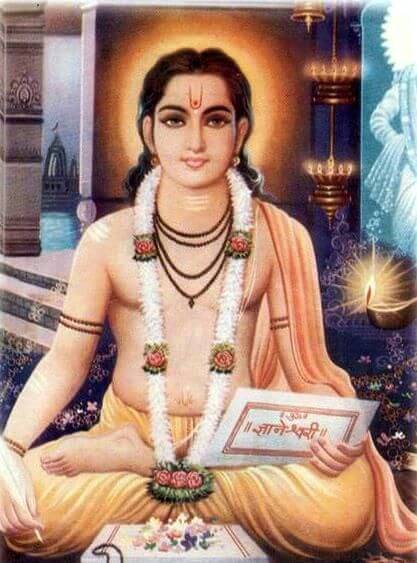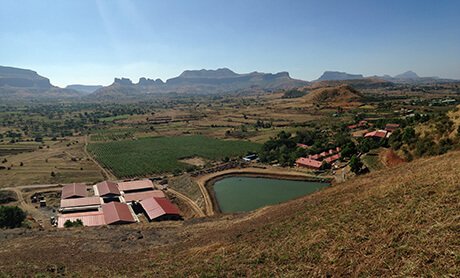
Jnaneshwar was born in the small town of Apegaon near Paithan, on the banks of the river Godavari, in Maharashtra, India on the 15th August 1275 at 12am. He took Sanjeevan Samadhi on the 25th November 1296 at 2.30pm. Though he lived for only 21 years he had an impact on millions and millions of people. He wrote many masterpieces that even now people have great difficulty in understanding.
At the age of 16 he wrote the Jnaneshwari, a commentary of the Bhagvad Gita, in Marathi. This was very special and important because up until this time all spiritual texts were written in Sanskrit and therefore only the Brahmin caste could read them. He brought this knowledge to the common person. A year later he wrote the Amritanubhav, which explains his own experience of self realisation and is a very difficult text to understand. He also wrote Changadeva Paasasthi which is a letter to the famous yogi Changadeva speaking on the absolute truth, individual jiva and nature of the world. He wrote many songs known as abhangs such as the hariphata. Abhangs are devotional songs in Marathi meaning “that which contains the indestructible essence.”
His father, Vitthal, had taken sannyasa whilst still married to his mother, Rakhumabai, and went off to live in Varanasi with his Guru, Ramanand Swami. However when his Guru found out that he had a wife he sent the man back to fulfil his duty with his wife and to have children. Their first child, a pure, calm and quiet son, was named Nivritti, meaning “without the stirring of a thought”. Second was said to have a face that glowed like the glow of the jnanis, knowers of God, he was named Jnaneshwar, “lord of knowledge”. Third was independent and pure Muktabai, “sister of freedom” and last was a boy, Sopandev, another name of Krishna. Vitthal was a Brahmin but because he has taken sannyasa and then gone back to the family life he was renounced of his Brahmin caste and could no longer do the work of a Brahmin priest, plus the people outcaste his whole family. Because of this it was very hard for him to find work and support his family and they had a difficult time. It was also a time of great instability in India due to the invasion of the Mughals.
When Jnaneshwar was about ten years old his parents died and they had to look after themselves. They travelled to Nasik to get certificates that they were Brahmin so they could take up work and learn in this area. Outside Nasik, in the holy town of Trimbakeshwar, Nivritti found his guru, Gahininath, a follower of the Nath tradition. His guru was Gorakshanath, whose guru was Matsyendranath and whose guru was Adinath/Shankara/Shiva. Nivritti, who became Nivrittinath, became the guru of Jnaneshwar.
Jnaneshwar, though he came from the Nath tradition, he taught the Bhagvad Gita and the focus was on bhakti yoga. He supported his teachings with jnana and karma yoga in everyday life. His teachings transformed the society. His whole life was dedicated to the upliftment of society and he had complete devotion to God/Higher energy. He re-established the Varkari movement which is a path combining vedic doctrines with jnana and bhakti. The Varkari movement is very strong in Maharashtra and is the framework for life in all its aspects. Its main practice is about remembering Hari/God at all times and living a simple, generous and virtuous life, helping others and looking after society, living a yogic life. His teachings invoked great devotion in common people. In the tradition there are particular days where people walk huge distances with bare feet, chanting the name of God without thinking of food or money. Followers walk hundreds of kilometres to the holy place of Pandhapur, to worship Lord Vitthal, a form of Hari. He strongly advocated jnana yukta bhakti, devotion guided by knowledge, and believed that one cannot be liberated unless one attains the true and divine knowledge of Brahman.
Though he mostly spoke on bhakti yoga he also spoke on patanjali yoga, jnana and karma yoga, explaining that they were all one path. He said that when one reaches the state of kaivalya or Samadhi there is experience of oneness, brought on by bhakti yoga and the next stage is the performing of karma yoga as a result of the experience of kaivalya or samadhi. This experience of universal oneness is knowledge and yoga is bhakti (heart), karma (action) and jnana (knowledge) together. He reached the stage of Samatwam Yoga Uchyate which is where one has achieved a complete state of balance, where there is total and complete merging with the universe.
Because he always lived a life in a higher state of existence, he could achieve control of everything and every aspect of life. It is said even that once he put his hand on the head of a water buffalo, connected himself with that buffalo and the buffalo started reciting the Vedas. One story narrates Jnaneshwar making a concrete wall fly in the sky taking him and his siblings to meet another yogi called Changdev. He spoke on Kundalini energy and on awakening the energy through various practices.
He faced many difficulties in his life and many learned people denied the basic human rights to him and his siblings, yet he always remained calm and balanced, giving the best of knowledge and practices throughout his short life, a true yogi in every aspect. It is said that when he was born he had already reached the first stage of Samadhi and that he left his body at such a young age because his work was finished and his body was naturally turning into light, which is an interesting phenomenon that is talked about in yogic texts as divine nature. It is the next realm of existence. He is inspiring millions and will continue to inspire and motivate millions of people through the teachings and his life and the great texts that he has left behind as his legacy.
| COURSE | Venue |
Phone - +91-9822770727
E-mail - yoga@yogapoint.com or yogapoint108@gmail.com

Yoga Vidya Dham, Kaivalya Nagari,
College Road, Nashik - 422005.
Maharashtra, India.
Phone - +91-9822770727 (for courses in ENGLISH)
+91-253-2318090 (For courses, in HINDI or MARATHI)
(Please call during 9.00 AM to 5 PM Indian Time)
E-mail - yoga@yogapoint.co or yogapoint108@gmail.com
Village Talwade, Trimbak, Nasik
Maharashtra,India.
Phone - +91-9822770727
E-mail - yoga@yogapoint.com or yogapoint108@gmail.com